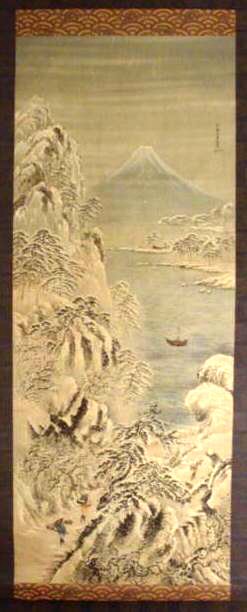

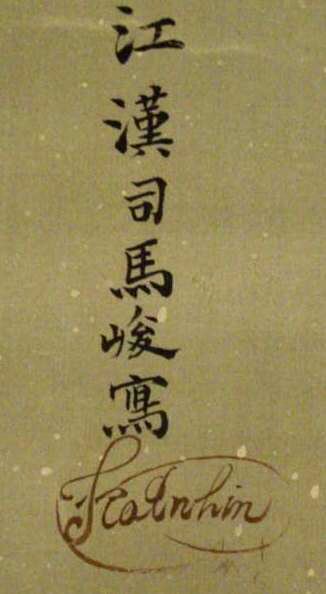
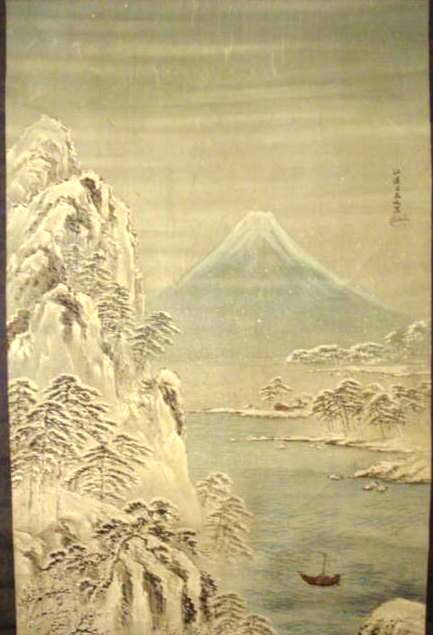
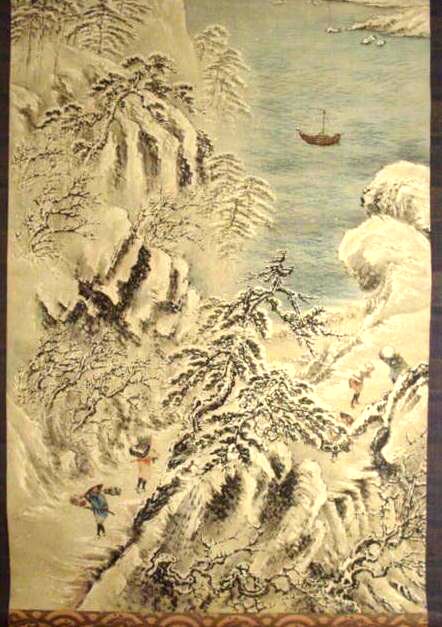
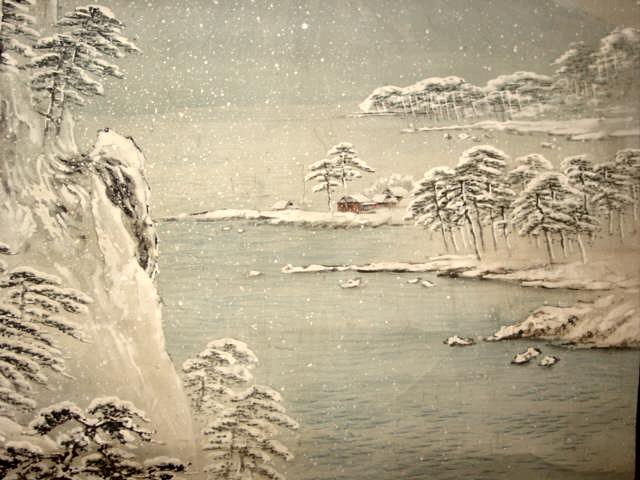
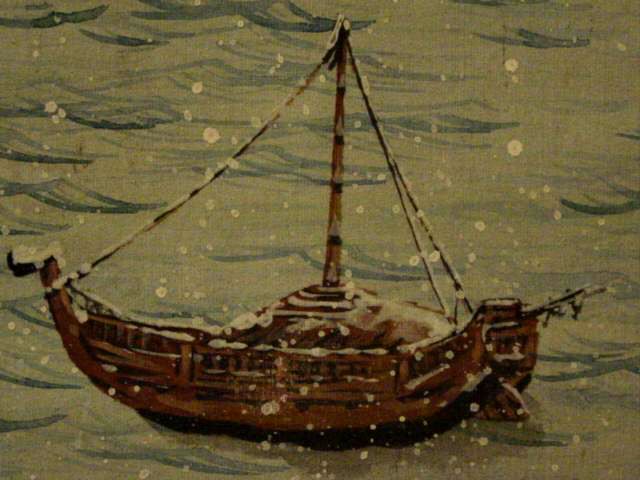
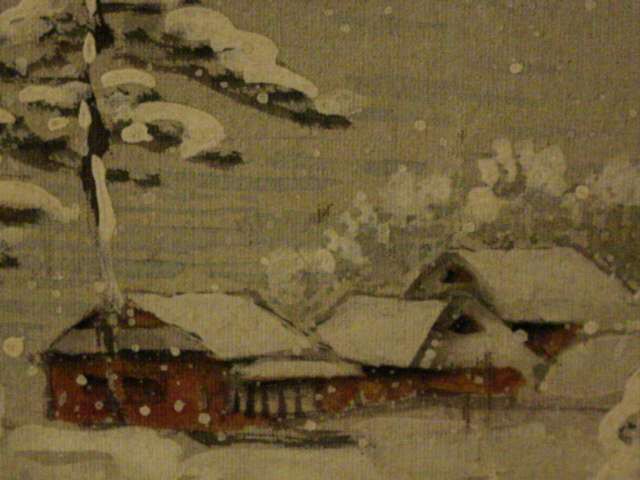
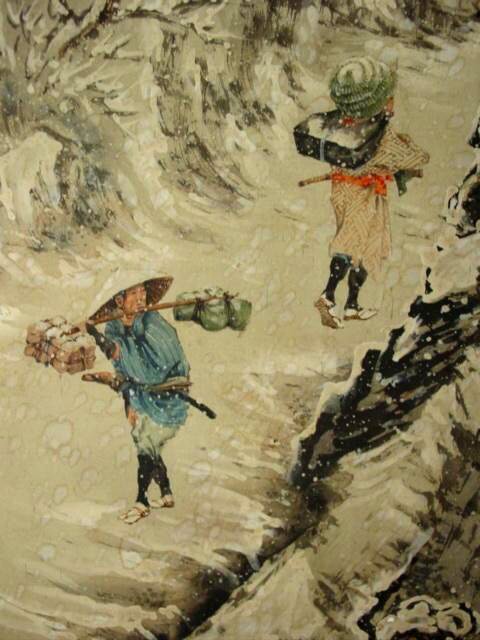
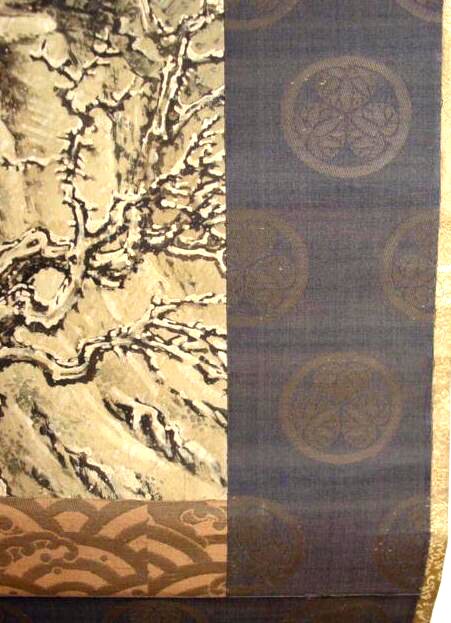
Watercolor Painting of a Winter Scene with Mt. Fuji by Japanese Master Shiba Kokan (1747-1818)
(painting area is 24.5 x 61 inches)
司馬江漢(1747-1818)富士雪景水彩畫
A Japan just awakening from centuries of introspection—a picture that is vital to an understanding of that nation's genius. Altogether this is a fascinating study of a most uncommon man and artist, of a germinal figure in Japan's modern history.
Shiba Kokan (1747-1818)
Born 1747, Edo [now Tokyo], Japan died 1818, Edo
Also called Kokan, or Shiba Shun, original name Ando Kichijiro, or Katsusaburo, pseudonym Kungaku Japanese artist and scholar of the Tokugawa period who introduced many aspects of Western culture to Japan. He was a pioneer in Western-style oil painting in Edo period and was the first Japanese to produce a copperplate etching.
=====================================================================================================
Shiba Kokan was in many ways the Leonardo da Vinci of Japanese history. Though he never reached the artistic heights of the Italian, he was still an artist of startling accomplishment; he played a formative role in the development of Japanese art; and he was certainly second to no one in his wide knowledge and inquisitive mind. At one and the same time he was : an ink painter in the traditional Oriental style, an admitted and unexcelled forger of Harunobu's woodblock prints, the artist who perfected in Japan the Western techniques of copperplate etching, the artist who introduced Western-style painting to Japan, the first Japanese astronomer to explain the Copernican theory, a geographer, a cartographer, a scholar, and a philosopher.He was a true Renaissance man, and his innate curiously and his conviction that Western knowledge should be widely disseminated in his country led him to become an irrepressible champion of Western learning in a feudal Japan that did little to encourage original thinking. Thus he was one of the early influences behind Japan's eventual emergence as a modern nation. (Based on Shiba Kokan by Calvin L. French)
Writing at the age of sixty-four, near to the end of a long life, Shiba Kokan summed up the conflict of his own nature in these words: Everyone, whatever his station in life, enjoys pictures, and if pictures are distinguished by color, even persons who know nothing about art will admire them. Today's styles of painting, both Chinese and Japanese, originated in China ….Japan has never invented anything… The excellence of a painting lies in the fact that one can see immediately things that could not otherwise be seen; therefore, if pictures do not portray objects accurately, they are neither admirable nor judged by the methods, spirit, or force of the brush as are Japanese and Chinese paintings… They never illustrate imaginary landscapes…nor are they ever executed before noblemen at official banquets. The art of painting, like that of writing, is not a frivolous pastime, but a national asset. The people of our country have no interest in investigating natural laws of universe and ignore such studies as astronomy and geography. They are shallow and lack wisdom. I live in Japan, however, and in trying to be different from my countrymen, I have made a great mistake.
In other words, he was on the one hand Japanese and a product of Japanese culture and, on the other, a heretic dissatisfied with the values and mores of his own society and committed to expanding the dimensions of Japanese thought. Hence he was peculiarly qualified to play the role of gadfly in Tokugawa Japan. To be different was to be subversive in that insular society. His government had chosen to exclude the nation from the rest of the known world. Kokan, who’s every interest centered on some aspect of the world
==============================================================================================
Shiba Kokan and advocates of the 'low-country'.
" Medical science cures illness with medicine. Relating this metaphorically to painting, let us call medical science the brush, illness the picture, and medicines the colours. The attempt of medical science to cure a specific illness with general medicine, or the attempt of the brush to correct a picture with colour, is like not knowing exactly where the illness originates or just what is at fault in painting. The primary aim of western art is to create a spirit of reality, but the Japanese and Chinese paintings, in failing to do this, become mere toys serving no use whatever." Shiba, Kokan.
As early as 1788 the scholar of Dutch studies, Shiba Kokan (1747-1818) was using a camera obscura to draw perspective. His interest in western art was, however, more scientific and pragmatic than aesthetic. He wanted a scientific meaning in art which, for him, the traditional arts lacked. Maruyama Oukyo (1733-95) seemed to foresee this problem of identity when he claimed that he had learnt about perspective from studying Chinese not Dutch painting. Okyo's realism went beyond traditional realism; he paid much more attention to anatomy, sketching figures in intriguing positions, and used megane-e to experiment with vanishing points. His screen painting of Pine Trees seems to show exactly the kind of dynamic combination of styles Okakura Tenshin later aimed for with Nihonga; a forging of western perspective and shading (naturalism) with a Japanese theme and atmosphere. He uses the technique of 'mokkotsu' -washes rather than lines of colour, to create a sense of three-dimensional space undefined by the Japanese word for space at that time which meant two-dimensional space. 'Okuyuki' or depth was a new concept.
In Seiyogadan Shiba Kokan categorically lists the elements of western art which were so 'useful' in portraying reality. These particular techniques he had learnt from an imported book he had acquired called Het Groot Schilderboek (The Comprehensive Painting Book, published 1707 in Amsterdam) which described and illustrated methods of composition, architectural drawing, colour, still life, perspective etc.. Shiba Kokan was able to understand the concepts through the illustrations rather than the Dutch text which must also have impressed upon him the informative nature of western art. He studied the foreign techniques through practice and in 1783 produced a copperplate etching of Mimeguri shrine and Sumida river in Edo, very aptly taking the western technique and format of a landscape and choosing a local scene for his subject matter. The copperplate etching method was infinitely superior to the traditional woodblock prints to Shiba Kokan; not only were the lines much finer and therefore precisely representational, but thousands of prints could be made from one plate. He also copied maps imported from Holland and was impressed by the new world which had suddenly become accessible to him through this new knowledge. Western maps are authentically representational and essential to navigation he told his fellow countrymen. "It is truly a great misfortune that we Japanese know so little about the heavens and earth we live in." (French, 1974: 129) It must have seemed to Shiba Kokan's critics that he had been seduced by a mirage. The lines of perspective places the painter or artist at the single prefixed view of the world. This anthropocentric attitude separates and opposes nature and man. If the self is an integral part of nature, nature is not external and objective and so representing the world as distinct from the subject is a futile exercise.
The Buddhist concept that human beings are part of their environment is known as Fuudosei. The human being is not only a viewer but a participator and so according to this view, art is an expression of this intuitive relationship. To represent nature in subjective terms is to reveal its true essence. Western art which relies on the assumption of perspective was, therefore, not 'art'. Shiba Kokan and other Rangakusha did not agree but bitterly attacked traditional art as being mere 'playthings', or 'frivolous and useless'. His criticism did not stop at painting. His explanation of why western science was so advanced was because, he felt, Chinese scholars wasted years learning how to read and write. He admired the phonetic alphabet which was so functional and accessible and saw it as the language system of a 'truly advanced civilization'. There were artists who did see the value of studying both western and traditional painting."Only when we know and understand both their methods and ours can we paint well, taking advantage of both of them." Hokusai Katsushika.============================================================================================
Chronology of Kokan's life and related events
1747 Shiba Kokan born in Yotsuya, Edo. Family name: Ando. Given name: Kichijiro, Names after marriage: Tsuchida MagodayO, Tsuchida Katsusaburo.
Pen and art names: Kungaku, Harushige, Shotei Harushige, Suzuki Harushige, Shun, Shumparo, Rantei, Seiyo Dojin.
Names assumed later in life: Togen, Mugon, Fugen Dojin, Mugon Dojin.
Posthumous name: Togen-in Kaiei Juenkoji.
So Shiseki: age 32 Suzuki Harunobu: age 22 Maruyama Okyo: age 14 Hiraga Gennai: age 13 Motoki Ryoei: age 12 Honda Toshiaki: age 3 1748 (1) Aodo Denzen and Satske Shozan born. 1749 (2) Odano Naotake and Ota Nampo (Shokusanjin) born. 1751 (4) Tokugawa Yoshimune died, age 67. 1752 (5) Kokan copied designs of sparrows. 1756 (9) Kokan drew pictures of Daruma. Otsuki Gentaku and Yamane Kazuma born. 1758 (11) So Shigan arrived in Nagasaki. Matsudaira Sadanobu born. 1759 (12) Haruki Nanko (Monya) and Wakasugi Isohachi born. 1760 (13) Tokugawa Ieharu became the tenth shogun. 1761 (14) Kokan studied in the Kano school. Kokan's father died. 1762 (15) So Shiseki became Kokan's art teacher. Kokan studied Chinese classics nod poetry under Karahashi Sesai and took the names Kungaku, Shiba, Kokan, and Shun. Ishikawa Tairo born. 1763 (16) Hiraga Gennai published Butsurui Hinshitsu (Classifications and Different materials), illustrated by So Shiseki. Tani Buncho born. 1764 (17) Hiraga Gennai made asbestos. 1765 (18) Harunobu perfected multicolor woodblock printing. 1767 (20) Tanuma Okitsugu became Grand Chamberlain under shogun Ieharu. 1769 (22) Tanuma became Senior Councilor. 1770 (23) Suzuki Harunobu died and Kokan began executing forgeries of his woodblock prints. 1771 (24) Maeno Ryotaku and Sugita Gempaku witnessed and autopsy and began their translation of Tabulae Anatamica. 1772 (25) Kumashiro Yohi died, age 59. 1773 (26) Kokan accompanies Hiraga Gennai to the Chichibu Mountains in search of precious metals. Gennai met Odano Naotake in Kakudate, Akita. Naotake went to Edo in December. Motoki Ryoei completed Tenchi Nikyil Yoho (Directions for the Use of the Two Charts of the Heavens and Earth), the first statement of the Copernican theory in Japanese. 1774 (27) Kokan ceased making ukiyo-e prints. Maeno Ryotaku and Sugita Gempaku published Kaitai Shinsho (New Book on Anatomy), their translation of Tabulae Anatomica 1775 (28) Until around 1781 Kokan executed ukiyo-e paintings, using the signatures Harushige and Shotei Harushige. 1776 (29) Ikeno Taiga died, age 53. 1777 (30) Odano Naotake returned to Akita in December. 1778 (31) Odano Naotake went again to Edo. Satake Shozan wrote Gako Koryo (Discussion of Painting). 1779 (32) Hiraga Gennai died, age 45. Odano Naotake returned to Akita. 1780 (33) Kokan met Isaac Titsingh in Edo in 1780 or 1782, and may have received Groot Schilderboek from him. Odano Naotake died, age 31. 1781 (34) Kokan drew sekiga for the lord of Sendai. Kokan's mother died, age 72, and he married into the Tsuchida family, taking then his wife's surname and assuming the names MagodayQ and Katsusaburo. 1782 (35) In April, Isaac Titsingh made a second journey to Edo. Mitsui Shinwa died, age 82. 1783 (36) Otsuki Gentaku assisted Kokan in translating the section on etching in Chomel’s encyclopedia, and Kokan produced his first copperplate etching, View of Mimeguri, Edo. Otsuki Gentaku published Rangaku Kaitei (Ladder to Dutch Studies). Yosano Buson died, age 67. 1784 (37) Kokan constructed a camera obscura and produced the etchings Ochanomizu, Oyaji Teahouse at Hiro, and Shinobazu Lake, Ueno. 1785 (38) Kokan produced the etching of a leather tanner. Satake Shozan died, age 37. 1786 (39) Kokan drew an illustration of a mermaid for Otsuki Gentaku's Rokubutsu Shinshi (Record of Six New Items), using as model the picture in Francois Valentijin's Oud en Nieuw Oost-Indien. Kokan produced the etching of Toranomon, Edo. So Shiseki died, age 71. Shogun Ieharu died and Ienari became the eleventh shogun. Tanuma Okitsugu resigned, and Matsudaira Sadanobu became Prime Minister. 1787 (40) Kokan drew illustrations of a microscope, insects and seeds, and Adam's Peak for Morishima Churyo's Komo Zatsuwa (Miscellany of Dutch Studies). Kokan produced the etchings Schichirigahama, Ryogoku Bridge, and Mimeguri. 1788 (41) Kokan departed for Nagasaki May 28. Met Kimura Kenkado in Osaka. Arrived in Nagasaki November 7. Left Nagasaki for Hirado December 11. Went to Ikitsuki-shima December 30. Motoki Ryoei appointed Chief Translator (Daitsushi) of Dutch at Nagasaki. Tanuma Okitsugu died, age 69. 1789 (42) Kokan left Ikitsuki-shima January 29, visited Kimura Kenkado again in Osaka, returned to Edo May 7. Kokan executed the oil painting Zeuxis. 1790 (45) Kokan published his first copperplate map Yochi Zenzu (Complete Map of the Earth) and geography Yochi Ryakusetsu (Brief Explanation of the Earth). 1791 (46) Kokan published Chikyu Zenzu (Complete Map of the World) and Chikyu Zenzu Ryakusetsu (Explanation of the Complete Map of the World). Motoki Ryoei completed Taiyo Kyuri Ryokaisetsu (An Explanation of Solar Physics), a translation of Gronden der Sterrenkunde (Principles of Astronomy) by George Adams. Hayashi Shihei died, age 55, after being confined to house arrest by Matsudaira Sadanobu for publishing Kaikoku Heidan (Military Discussion on a Maritime Country). Watanabe Kazan born. 1794 (47) Kokan published Saiyu Ryodan (Account of a Western Journey). Kokan executed the Picture Scroll of Whaling, and oil painting of whaling, and the etching A Western Studio. Otsuki Gentaku and his group of Rangakusha celebrated the Dutch New Year by the solar calendar (Kansei 1/11/11). Motoki Ryoei died, age 59. 1795 (48) Maruyama Okyo died, age 62. 1796 (49) Kokan published Oranda Tensetsu (Explanation of Dutch Astronomy), Tenyu Zu (Planisphere), and Tenkyu Zenzu (Complete Illustration of the Heavens). He presented his oil painting Shichirigahama to the Atagoyama Shrine, Edo. The mock playbill deriding Kokan was composed at Otsuki Gentaku's New Year's party. Ishikawa Tairo and his brother executed their copy of the floral still life by Willem Frederik van Royen. 1797 (50) Kokan published the revised and enlarged edition of Chikyu Zenzu Ryakusetsu. 1798 (51) Kokan's manuscript Oranda Kokudan-Oranda Zokuwa (Tales and Anecdotes of Holland) copied Kansei 10/2/18. 1799 (52) Kokan published Seiyoga Dan (Discussion of Western Painting) and completed Shumparo Gafu (Illustrations by Shumparo). The mock program of sumo wrestlers listing Kokan as contender number six opposing Matsubara Uchu was composed at Otsuki Gentaku's New Year's party. 1800 (53) Kokan presented his oil painting Kisarazu to the Itsukushima Shrine. He held an exhibition of paintings at his house in Shibamon, Shinsenza. Yoshio Kosaku died, age 76 Karahashi Sesai died, age 64. 1801 (54) Kitayama Kangan died, age 34. 1802 (55) Kimura Kenkado died, age 66. 1803 (56) Kokan published Gazu Saiyudan (Illustrated Account of a Western Journey). Maeno Ryotaku died, age 80. 1805 (58) Kokan published Hinkai Zu (Map of Navigation) and Oranda Tsuhaku (Ductch Navaigation). Wakasugi Isohachi died, age 46. 1806 (59) Kokan announced his retirement and held an exhibition of his paintings at Yanagibashi Restaurant in Edo. He visited Zeniya Gohei in Kanazawa, and verified as authentic the painting attributed to Rembrandt. 1808 (61) Kokan published Ryojusen Zusetsu (Explanation of Adam’s Peak), Chitengi Ryakuzukai (Illustrated Explanation of the Celestial Globe), and Kopperu Temmom Zkai (Illustrated Explanation of Copernican Astronomy). 1809 (62) Kokan published Chitengi Shimo (Enlightenment Concerning the Celestial Globe). He Presented his last votive offering, Kintai Bridge, to the Asakusa Shrine, Edo, and listed his other major paintings presented to shrines. Gessen, priest of Itsukushima Shrine, died. 1810 (63) Kokan completed the manuscript Dokusho Bogen (Self-laughter and Reckless Remarks). 1811 (64) Kokan completed the manuscript Shumparo Hikki (Notes by Shumparo). 1812 (65) In April, Kokan journey to Yoshima, Nara, Osaka, Suma, and Maiko Beach, and Kept a diary entitled Yoshino Kiko (Account of a Journey to Yoshino). He arrived in Kyoto in May, returned to Edo in December. On his painting Mount Fuji from Kashiwabara, Suruga, Kokan wrote: “Winter, 1812. Painted in Kyoto by Kokan Shiba of Edo, age seventy-five.” Issac Titsingh died, age 67. 1813 (66) In August Kokan became a disciple of the priest Seisetsu at Engaku-ji, Kamakura. He published his own obituary, giving his age as seventy-five. 1814 (67) Kokan completed the manuscripts Mugon Dojin Hikki (Notes by Nugon Dojin) and Kummo Gakai Shu (A Collection of Fables, Interpreted and Illustrated). Kokan's picture of a Eurpean basketmaker was published in Keijo Gasen (Kyoto Garden of Pictures) 1815 (68) Kokan completed his revised manuscript Saiyu Nikki (Diary of a Weestern Journey). Sugita Gempaku completed Rangaku Koto Hajime (The Beginning of Dutch Studies). 1816 (69) Kokan completed the manuscript Tenchi Ridan (Discussion on Astronomy and Geography). 1817 (70) Sugita Gempaku died, age 84. Ishikawa Tairo died, age 55. 1818 (71) Kokan died. He was buried at Jigen-ji, Edo. Later his grave was moved to Koshinzuka Cemetery, Nishi-Sugamo, Tokyo. ========================================================================================================
司馬江漢 (1747年∼1818)
江戶時代的西洋畫家。江戶的出生。本名安籐峻。無言道人﹒春波樓別名。狩野流派學、後拜在浮世繪大師鈴木春信門下、號春重。 並師從宋紫石學習畫人物、風景、山川等,以及南苹派畫法。1780年時候,受到平賀源內和小野田直武們的影響,對西洋畫也發生興趣,與平賀源內們交際,師從前原野澤裡學習蘭學。 並通過蘭學學習了西洋畫法。江漢於天明8年(1788)在長崎東海道遊學旅行,沿駿河游覽富士山,出版『西遊日記』和『西遊旅行譚』,並用插圖介紹 沿途風光。從長崎的遊學回來了後,致力於油畫的製作,不斷發表了 描繪以富士山作為主題,應用了從近景到遠景的西方透視圖技巧,並具有獨特日本風格的風景畫。其嶄新的技巧,對以後的日本畫壇,產生重大的影響。1783年,由於關心自然科學,成功創製了日本最初的腐蝕銅版畫,並應用於世界地理和有關天文學的書籍上插圖。1818年10月21日,以72歲高齡去世。
Click Here to See Other Japanese Paintings
Click Here to See Other Paintings
Click Here to Go Back to Homepage